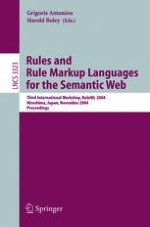2004 | Buch
Rules and Rule Markup Languages for the Semantic Web
Third International Workshop, RuleML 2004, Hiroshima, Japan, November 8, 2004. Proceedings
herausgegeben von: Grigoris Antoniou, Harold Boley
Verlag: Springer Berlin Heidelberg
Buchreihe : Lecture Notes in Computer Science
Enthalten in: Professional Book Archive
